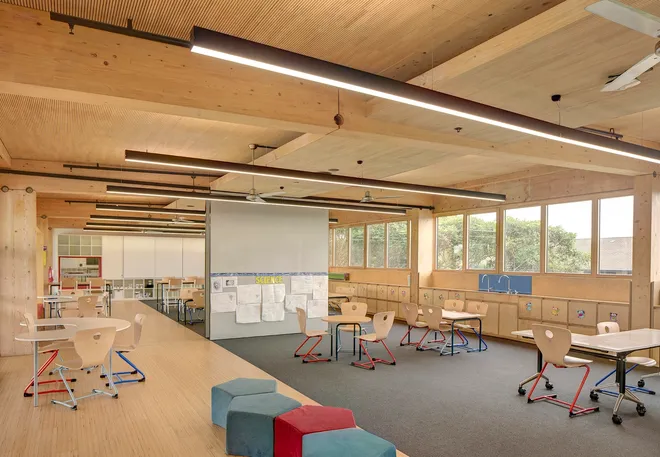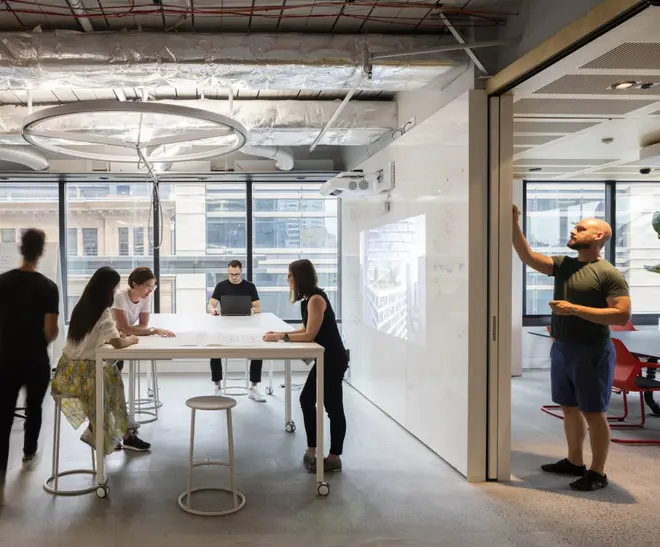News — May 31, 2019
Education, wellbeing and sustainability all under one roof
BVN was recently announced the category winner for Renovation/Modernisation Over $2M in the 2019 Learning Environments Australasia Awards for Excellence in Education Facility Design. The award recognises BVN studio’s transformational work on the Our Lady of the Assumption Catholic Primary School (OLA) Stage 2 project.
This prestigious acknowledgement comes after what has been a challenging project—taking a dark and gloomy, concrete 1970’s Telstra building, and turning it into a light, engaging and inspiring place of learning.

Our Lady of the Assumption Catholic Primary School reuses a 1970's brutalist former Telstra training centre
It is the second time the school and BVN have been recognised by Learning Environments, with Stage 1 having received the respected award in the same category in 2016.
We relished the challenge. It’s not often you get to take a piece of architecture that is as physically dense in form as this one and revitalise it, bringing in light and energy.
Knut Menden, BVN Senior Associate
A Vision for Wellbeing
OLA school had a very clear vision for the project. They wanted spaces for their teachers and students to awaken their imagination, encourage innovation, and to provide a physical space that stimulated independent learning. But more than that they wanted their students and teachers to embrace the new school as a place of wellbeing—both emotionally and physically. There are multiple studies indicating the use of timber application in school environments reduces stress and cortisol levels in students. The decreased level of stress encourages better learning outcomes, concentration, productivity, as well as promoting a sense of wellbeing. Timber has been used extensively throughout the internal spaces both structurally and as a finish.

The school library features a suspended reading pit
Sustainability as an Architectural Driver
However, timber’s positive attributes are not limited to enhancing wellbeing. The use of engineered timber is prevalent in Europe and North America, but it is still a relatively new concept to the Australian construction industry. The benefits of using timber are multifold; it is high-quality, precise, environmentally friendly and has greater energy efficiencies. As such, BVN are incredibly proud to be the first to use engineered timber to construct an educational facility in Australia.
OLA’s design features engineered timber ‘glulam’ columns and beams and cross laminated timber (CLT) walls and slabs. The school is a model for sustainability with CLT walls as well as a CLT acoustic ceiling flooring system. The exterior of the existing concrete structure and new CLT additions have been clad in a highly insulated, custom perforated zinc cladding façade.
Replacing part of the existing concrete façade with high-performance timber framed windows, allows for natural daylight and ventilation to penetrate the building. Windows and doors are double glazed to limit noise and distractions.
School Architecture
On entry, students, staff and visitors walk into a soaring, timber filled atrium which connects each floor in the four-storey building. An abundance of natural light fills the space through the large glass doors that connect to the playground on the ground floor and filters through the holes in the perforated façade that wraps around the building’s upper levels.
A large timber staircase laces through each level and connects class levels with a broad range of school facilities. There is a school library complete with a suspended reading net, administration areas and verandas. Outdoor playgrounds can be found on level 3 and on the rooftop. By removing most of the internal walls from the existing structure, class groups can gather either side of an open timber corridor that runs the length of the building. The design enables a diverse range of configurations for students to have an active role in their learning experience. Movable furniture such as beanbags and desks on wheels plus floor to ceiling sliding screens allow students and teachers to customise spaces to suit learning needs.
Class groups need only slide the screens further along to join their peers or close them off to split class groups into manageable sizes. Students can curl up with a book in a built-in alcove or concentrate on independent learning in one of the small pods that sit within larger teaching areas that are dedicated for quiet work or small groups. Spaces are scaled for different age groups with differentiations in ceiling heights and joinery. Large timber doors that open out to wide verandas run along the western end of the school allow fresh air to circulate and gives classes the option to take their learning outside.

The atrium stairs connect all levels of the four-storey building
Why OLA took out this award
Learning Environments jury citation: Our Lady of the Assumption Catholic Primary School has used architecture extremely effectively to support a rigorous planning process and an ambitious design brief. The result is a de-institutionalized and playful learning environment which perpetuates connectivity and current pedagogical strategies - a proud addition and amenity for the school.
Playful colours, natural materials and inviting 'nooks' blur the boundaries between learning and play whilst facilitating seamless transition between spaces. The end result highlights the high level of planning and attention to the 'guiding design principles'. The architects’ ability to integrate a sense of openness and accessibility throughout the multi-story building, whilst ensuring no compromise on the functional brief is inspiring.
In addition to an impressive list of ecologically smart initiatives, this school provides 'state of the art' education facilities with outstanding flexibility and opportunity for various multi-modal spaces.
With an engaging narrative which resonated with the school community right from the project initiation; a clever combination of natural materials and integrated gaiety brings the concept to life.
Overall, this building implements and symbolizes the 21st-century definition of a 'primary school' in a brilliant and exemplary way.

The school's perforated facade from the front entrance
For further information on the project, contact
daisy\_szakaly@bvn.com.au or mailto:daisy_szakaly@bvn.com.au


